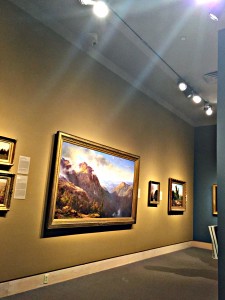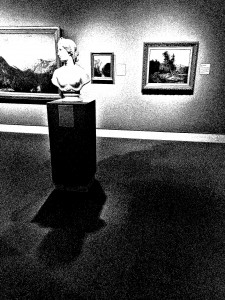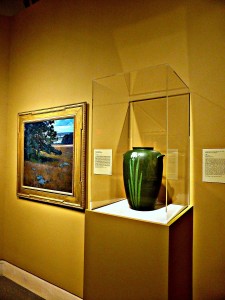Using Lighting to Show Where to Look

Although not immediately noticeable, the paintings on the walls are brightly lit by overhead spotlights, literally illuminating the main focus of the gallery. David Dernie describes lighting as “a vital part in the visitor’s experience…[it] affects the way in which an exhibition structure is perceived, the effectiveness with which it communicates, the rendering of form and colour and the legibility of graphics” (Dernie 136). How a space is lit, Dernie argues, corresponds directly with how a viewer may interact with a painting or sculpture. The spotlights in the Hood museum, mounted on the tall ceilings as to be out of the way of the viewer, cast their light directly onto the paintings and objects on display. This focuses the viewer’s attention, as it creates a surface that is both brightly lit and brightly colored. The intense light also allows encourages viewers to take in the details of an image instead of a general idea of the subject of the image, allowing viewers to analyze the painting more rather than just breezing by quickly.

This effect is most clearly noticeable in the bust at the center of the larger open space to the right of the entrance to the gallery. Lights shine from all around the bust, allowing all sides of the bust to be fully illuminated. This causes viewers to examine the entirety of the sculpture. They will find the wings on the back of the head of the bust strange, and will ask questions about why they are there. They will walk back around to the front and read the plaque, wondering if the answer to their question is there. Viewers, simply because of the extra light and focus on the sculpture, were made to interact with it, to think about it. Without the light, viewers might not have noticed the peculiarities of the bust, and would have moved on without fully "experiencing" it, so to speak.

Light is also used in the gallery to bring out certain aspects of the artifacts displayed. On the other side of the center structure of the gallery, there is a vase in a glass case. The light from the spotlights points down in the general direction of the vase just like the other artifacts and paintings in the gallery. However, the glass case focuses the light more carefully, drawing special attention to the flower near the top of the vase. The less important, less decorated parts of the vase are deemphasized by being cast in shadow. While the lighting of the bust encouraged viewers to interact with all sides of the sculpture, the lighting on the vase emphasizes a one-sided interaction between the viewer and the art, an interaction would still occur regardless of the artwork displayed in the case.

In a more general sense, downward-pointing spotlights create layers of light and dark that direct viewers where to look. Because all of the paintings are placed at a general eye level (as is convention in most art museums), there is a band of light that goes across all of the walls in the gallery, creating a smooth line for the viewer’s eyes to follow. The informational plaques of the paintings are also on the same level, meaning that the viewer does not have to break his or her interaction with the line of paintings. Without this break of flow, viewers are encouraged to provide their own interpretations of paintings as they read through the interpretations provided by the museum. The viewer is further encouraged to focus on the artwork through the contrast of the lit paintings and the darkness of the ceiling area, which also deemphasizes the spotlights.
While the lighting of the gallery emphasizes the actual art, it also very carefully crafts how viewers interact differently with different paintings and artifacts. It is not the subject matter or “beauty” of the paintings themselves that causes viewers to experience them differently, but rather how they are highlighted by the surrounding visual cues.